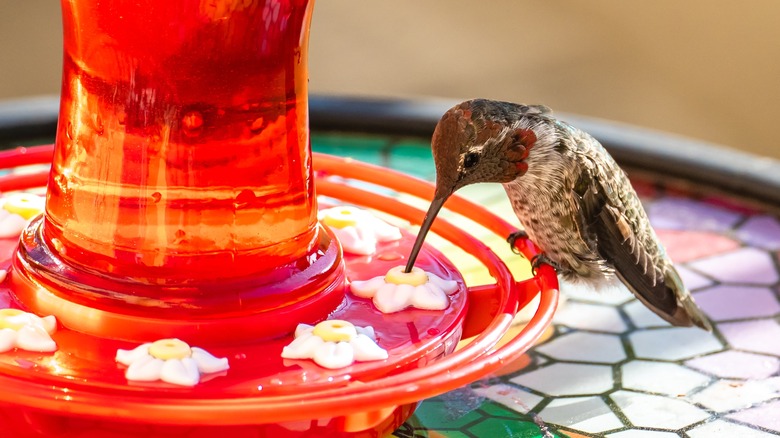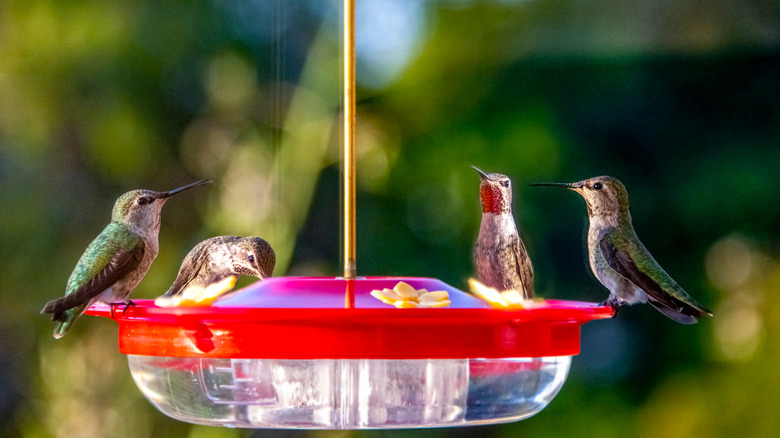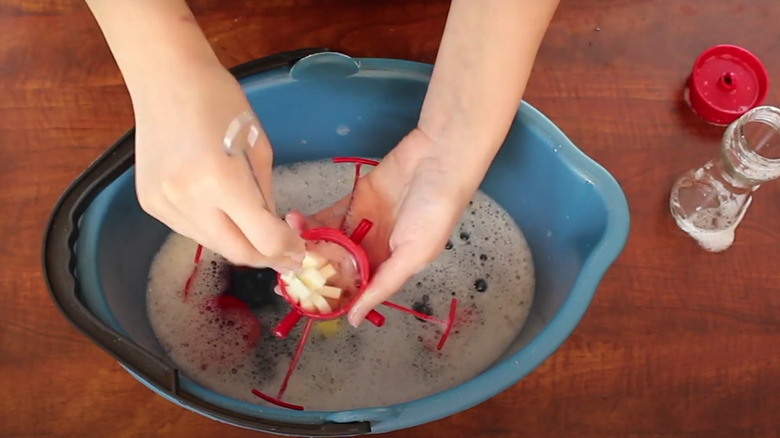Why It's Important To Change Hummingbird Feeder Nectar Daily In The Summer
According to the American Bird Conservancy, the Americas are home to over 300 different types of hummingbirds. This means that you may have already seen your fair share of them in your garden. Visiting hummingbirds make a joyous addition to any garden, but to keep these little birds happy in summer, you need to take some extra precautions, particularly when it comes to their nectar feeders. It's important to change your hummingbird feeder nectar as often as every day in the summer to maintain a fresh supply of food and keep the birds safe from spoiled nectar. It is also vital to help protect the quality of their food and to keep them returning to your garden.
While it may seem like no big deal, changing the nectar regularly is incredibly important. So, what is so dangerous for hummingbirds and nectar feeders when it comes to higher temperatures? Keep reading, and we'll discuss why it's essential that you change your hummingbird feeder nectar daily in the summer and just how it can tamper with the nectar quality.
It gives hummingbirds a fresh supply of food
To be fully clear, while experts agree that hummingbird nectar should be changed regularly during the summer, there is some debate on exactly how often that should happen. Opinions range from every day, as suggested by Wild Birds Unlimited, to twice a week, per Aududon, depending on your climate. Those with cooler summers and temps dropping into the 60s at night may be able to go two to three days between changes. But for very hot summers, especially if temperatures exceed 90 degrees Fahrenheit, or if you simply want to play it safe, it is best to change the nectar every day.
Not only does changing the nectar help to give the hummingbirds visiting your garden a fresh supply of food, but it can also deter any germs and bacteria from accumulating, which will help keep these little visitors safe. If the quality of your nectar is affected or is starting to spoil, you may notice more insects around it, a sour smell, and clogged feeder ports. If you notice this, it's definitely time to change it.
Keep an eye on the weather with an outdoor thermometer near the feeder in order to see when you need to change your hummingbird nectar. Though refilling the nectar daily may seem like a pain, doing so should help keep your feeder sanitary and, in turn, keep attracting hummingbirds to your garden. However, there are still other precautions to take when working with your hummingbird feeder, like making sure you clean your feeders.
Make sure you clean it during the summer months
Cleaning your hummingbird feeders is always important, but it's even more important during the hotter summer months or when nectar is left out for longer. Even if you're changing your hummingbird feeder nectar daily in the summer, regularly cleaning the feeders will help keep them sanitary and in good condition for any birds that decide to pay a visit.
Speaking to the UC Davis's College of Agricultural and Environmental Sciences, ecologist and assistant professor Rachel Vannette explained, "Although we found high densities of both bacteria and fungi in sugar water samples from feeders, very few of the species found have been reported to cause disease in hummingbirds. However, a tiny fraction of those microbes has been associated with disease, so we encourage everyone who provides feeders for hummingbirds to clean their feeders on a regular basis."
To clean your hummingbird feeders, wash them in a combination of warm water and dish soap in your sink or dish tub. Ensure that you get into every nook and cranny, including the feeding tubes. This may require some smaller tools, such as a bristle brush. (Although it may seem tedious, it will help you get the job done correctly.) Finish by rinsing with clean water and letting the feeders air-dry in the sun.


